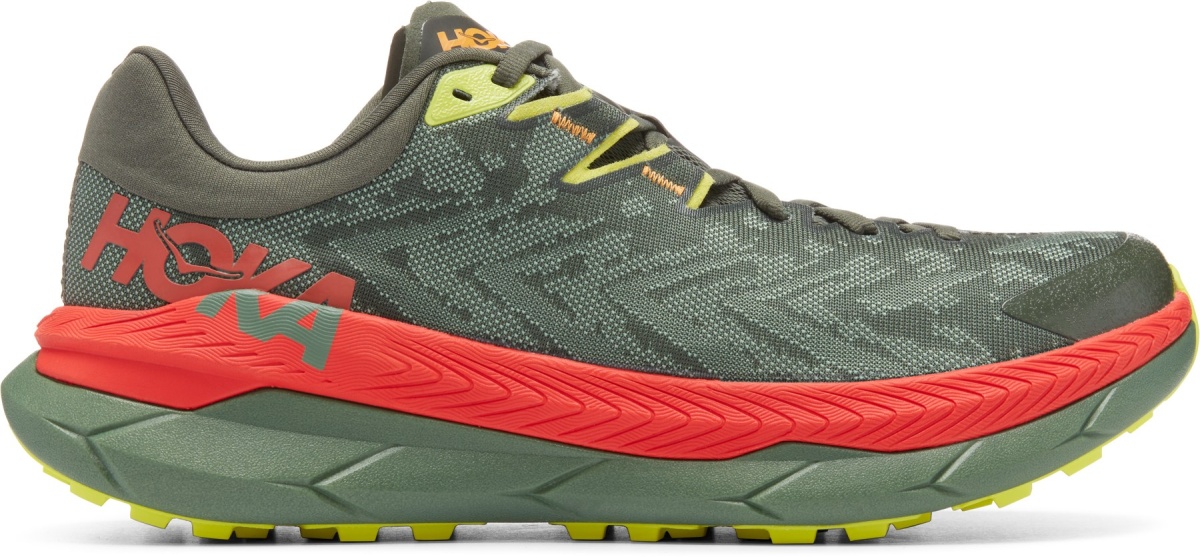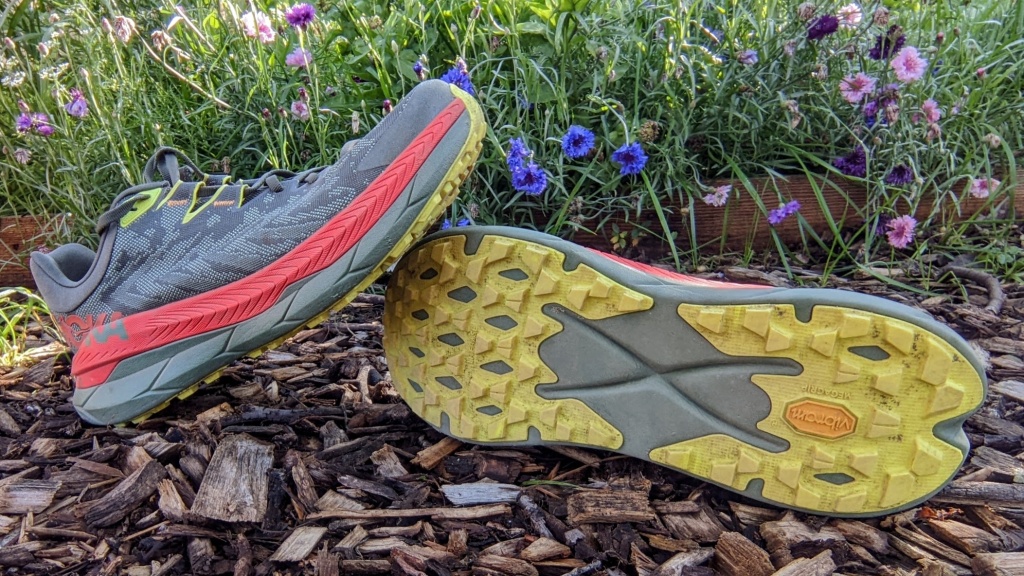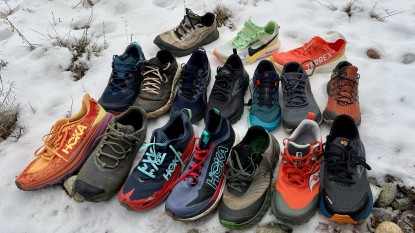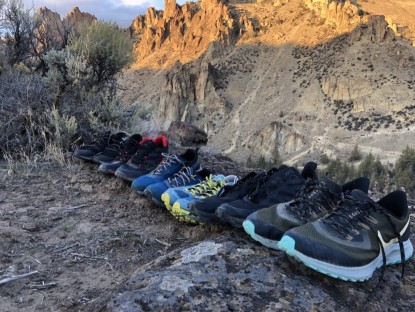Hoka Tecton X Review
Our Verdict
Our Analysis and Test Results
The HOKA Tecton X pushes the boundaries of trail running shoe technology by incorporating parallel carbon fiber plates into the midsole layup. Instead of a full carbon fiber shank, HOKA designers opt for two narrow carbon fiber plates. These plates are sandwiched between their ProFlyX EVA midsole, a proprietary design that couples two individual foam bases. The remaining construction of this ultralight, 9-ounce shoe is all about minimalism. A Vibram Megragrip outsole uses their Litebase technology to separate the outsole grip into two individual sections covering just the heel and forefoot.
Foot Protection
Although this shoe boasts a stack height of 32mm in the heel that drops only slightly to 27mm in the forefoot, you don't feel like you're standing on a pillow. The difference between the Tecton X and other ultra-cushy ultrarunners is in the midsole construction. The dual-layer ProFlyX midsole design is slightly stiffer than the single-layer ProFly foam used in other popular HOKA shoes. Couple that with the dual carbon fiber plates that run along either edge of this shoe, and the result is a firm ride that offers as much responsiveness as protection. The design also includes a stiff rubber toe cap that provides protection and structure to the otherwise ultralight, Jacquard-knit upper.
Looking at the profile of the Tecton X, you will likely notice that this shoe has two distinct midsoles, with carbon fiber plates sandwiched in between. Another eye-catching feature of this inventive design is the lacking outsole — or at least, the lack of a traditional outsole. By utilizing Vibram's Litebase technology, designers can split the outsole, exposing the bottom midsole directly underfoot. The midsole stack is fat enough that you won't notice any terrain features poking through. However, we worry about this design's long-term durability, especially for those who regularly run in rocky terrain.
Traction
While the Vibram Litebase technology certainly shaves weight from the Tecton X, that weight savings comes at the cost of traction. When you flex into a shoe to grip on uphills or go to throw on the brakes on downhills, you engage the outsole in the toes or just in front of your heel, respectively. But when you are cruising long miles of hardpack doubletrack — a specialty of the Tecton X — you tend to move more around the ball of your foot. It seems trivial, but cutting out a section of the outsole that extends from just behind the ball of your foot to just in front of your heel reduces your ability to grip through this part of your foot. This is especially true of midfoot strikers, who already have to scramble to find grip through the short 4mm lugs. You won't slip and fall on your face, but don't expect the minimal Megragrip outsole to help with propulsion.
Sensitivity
As you may have already guessed, the Tecton X is not designed to be an agile alpine runner. The wide platform of the forefoot, thick midsole, and the added stiffness of the carbon fiber plates make this shoe a dream for running long miles over mellow, rolling hardpack. But it does not offer the agility, proprioception, or flexibility for nimble foot placements in technical terrain. The neutral stance and minimal drop of the Tecton X put you in a more natural alignment with the ground. However, few other shoes we have tested have as fat of a stack, or as stiff of a midsole, as the Tecton X.
Stability
Although the last isn't nearly as wide as other similar shoes we have tested, the platform of the Tecton X is much wider. The midsole flairs away from the upper, providing an ample base that feels like it was designed specifically for long-distance runs over simple terrain. Unlike other carbon shoes that incorporate a full shank, the parallel carbon plates don't influence your stride with any prescriptive midsole geometry. The result is a neutral shoe that is very wide, very damp, and very supportive. While all of this holds true over flat ground, unfortunately, this sense of stability does not translate well to off-camber trails. Like other carbon shoes we've tested, the midsole is too stiff and powerful for the ultralight upper. This causes your foot to bounce around in uneven terrain, which is particularly noticeable (and uncomfortable) when side-hilling.
Comfort
Fortunately, side-hilling was the only time we were uncomfortable in the Tecton X. Aside from those particular situations, this is an outrageously comfortable shoe. The last and sock liner provide a comfortable wrap through the midfoot, which widens out in the toe box to accommodate the normal foot swelling that occurs when running long distances. HOKA's proprietary ProFlyX midsole design merges two different EVA foams: one that is stiff and responsive; the other that is ultra-plush. Factor in the added torsional stability of the dual carbon fiber plates, and the result is a shoe that can help you push through your longest days.
Weight
Perhaps the most incredible thing about the Tecton X is that you receive the benefit of this technology without any of the added weight. Compared to their other trail offerings, the HOKA design team somehow managed to add all of this material while cutting weight. The Tecton X is quite lightweight, tipping the scales at an impressive 18.1 ounces for a pair of men's 9.5 US.
Should You Buy the HOKA Tecton X?
The short answer is: it depends. This inventive shoe carries a price tag commensurate with the technology and design hours it took to produce such a ground-breaking trail runner. If your running style favors long days over forest roads, this is the perfect shoe for you — and it may be able to help push your PR if racing. But if you enjoy running rough, technical, alpine trails, we highly suggest looking elsewhere.
What Other Trail Running Shoes Should You Consider?
We tested this shoe alongside the Saucony Endorphin Edge, another innovative carbon-fiber shoe worthy of comparison, even though it did not score as highly as the Tecton X. Long-distance runners or long-standing fans of HOKA shoes should consider the Torrent 3, a more versatile shoe that is likely to open up more terrain options.












